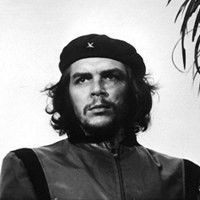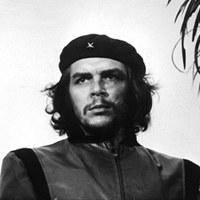Rosario (Argentina), 1928 – Oruro (Bolívia), 1967
By Fernando Martínez Heredia
Ernesto Guevara de la Serna was born on June 14, 1928, in Rosario, Argentina, into a family of higher social than economic status. His parents were lenient with him because he suffered from severe asthma since childhood, which required him to restrain his energy, enhancing his taste for reading. When he finished high school in 1946, he moved to Buenos Aires, where he worked as a soil laboratory technician and began studying engineering, but in 1947 he switched to medicine. He played rugby and chess and traveled 4,500 km by motorcycle to explore his country. In 1951, he worked as a nurse on merchant ships, always continuing to study. At the end of that year, he set off by motorcycle with his friend Alberto Granado on an eight-month journey through South America, which helped him find his vocation. He graduated in medicine and left again in July 1953. He wished to fight social injustice and be a benevolent doctor. He traveled through Bolivia, Peru, Ecuador, Panama, Costa Rica, and arrived in Guatemala increasingly interested in popular politics. He lived poorly, as always, and began participating in a movement that was destroyed by the CIA. With the fall of Jacobo Guzmán Arbenz’s government, Ernesto went to Mexico in September 1954, where he took on some sporadic jobs until July 1955, when he met Fidel Castro. They became friends, and soon he began participating in the July 26th Revolutionary Movement (MR-26), sharing training, hardships, and persecutions until the Granma expedition took place.
The doctor called Che was wounded in the first combat, on December 5. His outstanding performance made him the first revolutionary promoted to commander on July 12, 1957. From that time, he acted as column chief but was one of the most prestigious leaders of the Rebel Army (ER). He founded Rebel Radio on February 24, 1958, and directed the ER recruit school. He was one of the leaders of the counteroffensive that defeated the large Army of tyranny in the Sierra Maestra in the summer of that year. At the end of August, Fidel tasked him with commanding Column 8, “Ciro Redondo,” with the mission to invade Las Villas, unify the rebels, lead the province, and cut the island’s communications. Column 2, “Antonio Maceo,” was to make a parallel invading route and proceed to Pinar del Rio. Its leader was Camilo Cienfuegos Gorriarán, a Havana native, Granma expeditionary, lieutenant and later captain in Che Guevara’s column, who became his friend. Camilo was chief in the plains of the East from March to May; promoted to commander, he was one of the heroes of the summer battles. Camilo and Che Guevara stayed together in Las Villas from October until the final campaign. Che Guevara unified and organized the rebels, and the MR-26 joined the DR-13 of March, fulfilled their missions, and launched an offensive that took the province’s towns and culminated in the Battle of Santa Clara. The city surrendered on January 1, and with that, the dictatorship fell. Che Guevara and Camilo were the first rebel leaders to enter Havana.
Che Guevara was one of the main leaders of the Cuban Revolution. Military leader, president of the National Bank, minister of industry, member of the political leadership, Cuba’s representative abroad, organizer of militant internationalism, profound orator, and charismatic individual, he shone in all fields of revolutionary activity. Always united with Fidel, he pushed forward the most advanced positions and ideas within the process. He was the principal theorist of the Revolution; his thought is one of the reference points of 20th-century Marxism, and texts like Socialism and Man in Cuba demonstrate the existence of a theory and a liberating Latin American project.
In April 1965, Che Guevara resigned from his positions and went on a clandestine mission: to lead a Cuban contingent helping the revolutionaries in the Congo. They fought but did not succeed. The Cubans withdrew on November 21. Che Guevara went to Tanzania and waited for his next mission, which would be in Bolivia. He left with a group of Cubans in November 1966, leaving his Message to the Peoples of the Tricontinental. The National Liberation Army was made up of Bolivians, Cubans, and Peruvians, who aspired to spread the Revolution throughout the region. They began fighting in March 1967 under increasingly adverse conditions. On October 8, at Quebrada del Churo, Che Guevara was wounded and captured. The next day, he was assassinated.
Ernesto Che Guevara is one of the most transcendent personalities of the 20th century.




